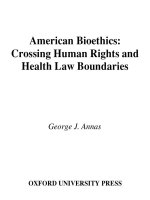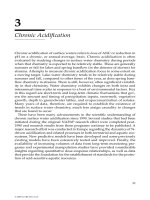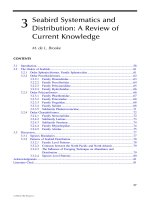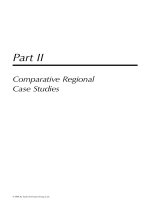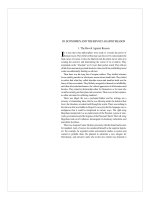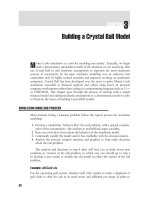Radiation and Health - Chapter 3 pot
Bạn đang xem bản rút gọn của tài liệu. Xem và tải ngay bản đầy đủ của tài liệu tại đây (196.19 KB, 6 trang )
Chapter 3
Radioactive Decay Laws
Half-life
The term half-life was mentioned earlier. So far, this has referred to only the
physical half-life. When considering health and the environment, biological
half-life is also used.
The Physical Half-life
The radiation from a radioactive source will gradually be reduced. The rate of
this decay is given by the half-life. It is usually denoted as t
½
but sometimes
denoted as t
p
for the physical half-life. In an experiment in which the intensity of
the radiation is measured versus time, a curve like that shown in Figure 3.1 is
observed. The activity of the radiation is given along the vertical axis (100%
when the experiment is started) and the time (in half-lives) is given along the
horizontal axis.
The half-life is defined as the time elapsed when the intensity
of the radiation is reduced to one half of its original value.
This chapter contains the
necessary information for
those interested in estimating
doses and carrying out risk
calculations in connection
with radioactive fallout
© 2003 Taylor & Francis
22
Radiation and Health
Figure 3.1. The radiation from a radioactive source decreases with time as
shown. The curve can be described by an exponential formula. The figure
demonstrates the meaning of the half-life.
Time given in half-lives
Activity given in percent
After one half-life the intensity of the radiation has decreased to 50%. After
two half-lives only 25% remains and so on. Each half-life reduces the remaining
amount by one half.
The Earth still contains large amounts of naturally occurring radioactive isotopes,
such as U-238. For this to occur the half-lives must be very long. We saw in
Figure 2.3 that U-238 has a half-life of 4.47 billion years.
The Laws of Radioactive Decay
The activity of a radioactive source (A), i.e. the number of disintegrations per
second (becquerel), is given in the following way:
A = –dN/dt =
λ
.
N (3.1)
λ is the disintegration constant and it varies from one isotope to another. N is
the number of atoms that, in time, will disintegrate and dN is the change in N
during the time interval dt. The negative sign shows that the number remaining
is decreasing.
© 2003 Taylor & Francis
23Radioactive Decay Laws
Biological Half-life
The radioactive isotopes that are ingested or taken in through other pathways
will gradually be removed from the body via kidneys, bowels, respiration and
perspiration. This means that a radioactive atom can be expelled before it has
had the chance to decay. The time elapsed before half of the compound has been
removed through biological means is called the biological half-life and is usually
written t
b
.
Equation 3.1 shows that when N is larger, the radioactive source is stronger.
The difference in activities from one isotope to another is due to the different
half-lives which depend on different disintegration constants λ (see equation
3.3).
In order to determine how the the number of atoms (N) decreases with time, the
change in N must be summed over time. This is done mathematically by integrating,
giving:
(3.2)
N
o
is the number of radioactive atoms at time zero (i.e., when the first measurement
was made). By substituting a later time (day, year) for t in (3.2) we can solve the
equation and determine the radioactivity at the new time.
The two equations (3.1) and (3.2) are very important in order to evaluate risks
and radiation doses. These equations are used in the examples presented in
Chapter 14.
It was noted above that there is a relation between the half-life (t
1/2
) and the
disintegration constant λ. The relationship can be found from equation (3.2) by set-
ting N = ½N
o.
This gives:
where ln 2 (the natural log of 2) equals 0.693.
If the disintegration constant (l) is given, it is easy to arrive at the half-life, and
vice versa. In calculations using radioactive compounds one of these two constants
must be known.
NNe
o
t
=⋅
−
λ
(3.3)
t
12
2
/
ln
=
λ
© 2003 Taylor & Francis
24
Radiation and Health
If a radioactive compound with physical half-life t
p
(t
1/2
) is cleared from the
body with a biological half-life t
b
, the “effective” half-life (t
e
) is given by the
expression:
If t
p
is large in comparison to t
b
, the effective half-life is approximately the same
as t
b
.
The biological half-life is rather uncertain compared to the exact value of the
physical half-life. It is uncertain because the clearance from the body depends
upon sex, age of the individual and the chemical form of the radioactive substance.
The biological half-life will vary from one type of animal to another and from
one type of plant to another.
Cs-137, having a physical half-life of 30 years, is a good example. It was the
most prominent of the radioactive isotopes in the fallout following the Chernobyl
accident in the Ukraine. Cesium is cleared rather rapidly from the body and the
biological half-life for an adult human is approximately three months and
somewhat less for children. Cs-137 has a biological half-life of 2 to 3 weeks
for sheep, whereas for reindeer it is about one month.
Due to the fact that the biological half-life for animals like sheep is rather short,
it is possible to “feed down” animals, with too high a content of Cs-137, before
slaughtering. The animals can simply be fed non-radioactive food for a short
period. Another possibility is to give the animals compounds such as “Berlin
blue” which is known to speed up the clearance of cesium from the body. The
result is a shorter biological half-life.
Some radioactive species like radium and strontium are bone seekers and,
consequently, are much more difficult to remove. The biological half-life for radium is
long, and if this isotope is ingested, it is retained the rest of one’s life.
It is possible to reduce the effects of a radioactive compound by simply pre-
venting its uptake. Consider iodine. If people are to be exposed to radioactive
iodine, it is possible to add non-radioactive iodine to their food. All iodine
isotopes are chemically identical and the body can not discriminate one isotope
from the other. There will be a competition between the different isotopes. If the
amount of non-radioactive iodine is larger than the radioactive isotope the uptake
of radioactivity is hindered. This kind of strategy can also be used to decrease
the biological half-life.
111
ttt
epb
=+
or: (3.4)
t
tt
tt
e
pb
pb
=
⋅
+
© 2003 Taylor & Francis
25Radioactive Decay Laws
C-14 used as a biological clock
C-14 emits β-particles. Since the energy is
small (max. 156 keV) and since the number of
disintegrations is small, the usual C-14 dating
method has several problems. It requires
rather large samples (many grams) in order to
yield enough radiation to provide a high degree
of certainty in the age determination.
Carbon dating is based on the measurement of
β-particles from C-14 atoms that disintegrate
during measurement. For each becquerel
there are 260 billion C-14 atoms (see example
1 in Chapter 14). Consequently, if one could
observe the total amount of C-14 atoms in
a sample (not only those disintegrating per
second), both the sensitivity and the age
determination would be increased.
Radioactive carbon (C-14) has a half-life of 5730 years. In spite of this rather “short”
half-life, C-14 is a naturally occurring isotope. It is created continuously in the atmosphere
when neutrons (originating from cosmic radiation) interact with nitrogen atoms. Carbon
exists in the atmosphere as a component of carbon dioxide and enters the biosphere when
plants utilize carbon dioxide in photosynthesis. All biological systems, plants, animals and
humans contain a certain level of C-14. The uptake of C-14 stops with death. From then
on, the radioactivity will decrease according to the curve below. The percent decrease can
be used to determine the age of organic materials, such as wood. The use of C-14 to
determine age is called carbon dating.
Decay of C-14
14
C =
14
N + β
Formation of C-14
14
N +
1
n =
14
C +
1
H
The curve
demonstrates
the decay of C-14.
Activity in percent
Years
0 5730 11460
100
50
25
12.5
The American physicist Louis Alvarez
developed a dating method based on this
principle. He used a very sensitive instru-
ment, called a mass spectrometer, that detects
C-14 atoms based on their atomic mass. He
measured the total number of C-14 atoms,
not only those that disintegrated during the
observation period. With this technique, it
was possible to date very small samples (a few
milligrams).
Nuclear tests that in the past were conducted
in the atmosphere released neutrons that
increased the formation of C-14. Because
of the 5730 year half-life, we will have these
extra C-14 atoms for a long time.
Could it be a log from a viking ship?
Let us date it.
© 2003 Taylor & Francis
26
Radiation and Health
Radio-ecological Half-life
Radio-ecological half-life is less precise than the physical and biological half-
life. Consider a region which has been polluted by a radioactive isotope (for
example Cs-137). Part of the activity will gradually sink into the ground and
some will leak into the water table. Each year, a fraction of the activity will be
taken up by the plants and subsequently ingested by some of the animals in the
area.
Radio-ecological half-life is defined as the radioactive half-life for the animals
and plants living in the area. It varies for the different types of animals and
plants. Knowledge in this area is limited at present, but research carried out
after the Chernobyl accident has yielded some information.
Here is one example from that accident. It describes the radioactivity in trout in
a small lake in the middle of Norway. The measurements were begun the spring
of 1986 and carried out for a 4 year period. The results are given in Figure 3.2.
Remember that to determine a half-life we need to use an exponential equation
(see equations 3.2 and 3.3). But the data shown in the above figure does not fit an
exponential function. Therefore, it is impossible to arrive at a single ecological
half-life. However, as Figure 3.2 indicates, the half-lives are approximately 3.0
years for Cs-137 and 1.3 years for Cs-134. It is important to note that these
ecological half-lifes are significantly shorter than the respective physical half-
lifes, 30 years for Cs-137 and 2 years for Cs-134.
Figure 3.2. Radioactive trout after the Chernobyl accident given in becquerel
per kg (note the logarithmic scale). The lake is covered with ice each year, as
given by the heavy lines.
(Courtesy of Anders Storruste, Inst. of Physics, Univ. of Oslo)
Bq per kilo
Ice Ice Ice Ice
Fallout
© 2003 Taylor & Francis
